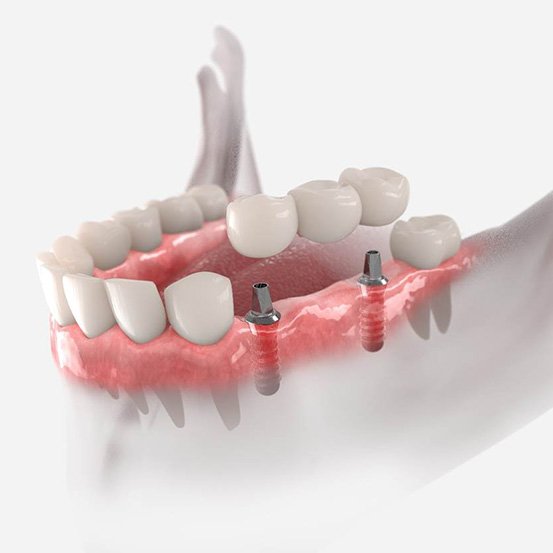Dental Bridges – Upper Arlington, OH
Close the Gap & Boost Your Confidence
If you are missing multiple teeth in a row, we don’t have to use a separate treatment to replace each of them. Instead, Dr. Jayme Glamm can seamlessly close the space, restore your appearance, and preserve your oral health using a custom dental bridge in Upper Arlington, OH. She has helped countless patients in your exact situation using this treatment, and thanks to her experience, training, and attention to detail, your result will help you look and feel like your teeth were never gone.
Why Choose Glamm Dentistry For Dental Bridges?
- Partnered with Local Dental Implant Experts
- All Bridges Are Custom Designed For Each Patient
- Warm, Friendly, & Professional Atmosphere
What Is a Dental Bridge?

A dental bridge gets its name because it literally bridges the space left by one or more consecutive missing teeth. Dental crowns are placed on either side of the gap, and these are connected to additional crowns that link between them.
Types of Dental Bridges

Not all bridges are exactly the same! Like with every other treatment Dr. Glamm provides, she will be able to offer you alternatives so you can choose the type of bridge that suits your situation. Factors like the current state of your mouth, your goals, and your budget can all influence which one would suit you best, and Dr. Glamm will be sure to share all the information you need so you can make a confident decision about your care.
Traditional Dental Bridges

With traditional bridges, the supporting crowns on either side are placed over the neighboring remaining healthy teeth. They will be slightly reshaped so the prosthetic fits seamlessly. These bridges tend to be less expensive compared to dental implant bridges and also require less time to get.
Dental Implant Bridges

Dental implant bridges are anchored directly to the jawbone using two tiny titanium posts that are precisely positioned where a patient’s teeth used to be. These implant crowns are then connected to more crowns in between that make up the bridge. The advantage is that implant bridges tend to be more stable and natural-looking than traditional ones, plus they help preserve the strength of the jawbone in the area thanks to the posts.
The Benefits of Getting a Dental Bridge

- Restore your confident and natural appearance
- Balance your bite to prevent accelerated wear on your remaining teeth
- Prevent your teeth from shifting into the gap and becoming misaligned
- Stop bite/TMJ problems that can lead to jaw pain and headaches
- Stimulate the jaw to avoid bone loss (implant bridge only)
- Make it easier to speak and chew comfortably
Dental Bridges FAQs
Can You Take a Dental Bridge Out?
Dental bridges are not designed to be removed; they’re meant to be a semi-permanent method of replacing teeth in the mouth. Putting them in place means either adhering them to the natural teeth via a strong dental adhesive or attaching them to implants that are placed into the mouth. This means that you can only expect to remove them with the assistance of a dental professional.
Is a Partial Denture the Same as a Bridge?
Partial dentures are sometimes referred to as “removable bridges,” though this is a little bit of a misnomer. Bridges are typically designed to be held squarely in place, while partial dentures simply clip on to the surrounding teeth for easy removal. Bridges also tend to be made from some kind of ceramic, while dentures are typically constructed from acrylic.
Finally, partial dentures can be designed in such a way as to replace several different teeth in a variety of places in the mouth. This is not usually possible with bridges, which can really only replace teeth that are right next to each other.
How Many Teeth Can a Dental Bridge Replace?
Dental bridges can potentially replace as many as four consecutive teeth, though they’re used most often to help patients missing only one or two. This is because the more teeth there are on a dental bridge, the more unstable the restoration becomes, and the more pressure is placed on the natural teeth.
Implant bridges can make replacing more teeth less risky, so they’re an option worth considering if you’re missing three or four of your teeth.
Can Dental Bridges Get Cavities?
Dental bridges themselves are made of a sophisticated ceramic, which means that they are essentially invulnerable to any kind of tooth decay. However, the teeth underneath the bridges are another story; it’s possible for bacteria and food to sneak their way under the dental crowns and to attack the enamel, which is why it’s still crucially important that you remain consistent with your dental hygiene. This risk also increases as the dental bridge nears the end of its lifespan, so you should be sure to visit our office regularly so that we can check the integrity of your dental work.
